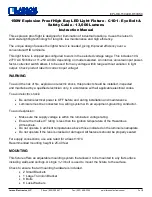
ACCOPPIAMENTO
ELETTRICO
L’accoppiamento elettrico e’ a cura dell’utiliz-
zatore finale ed e’ eseguito secondo la sua
sola discrezione.
Per l’ingresso nella scatola morsetti si racco-
manda di utilizzare passacavi e serracavi in
accordo con le specifiche del paese di
esportazione.
Collegamento avvolgimenti
Sono previsti entrambi i collegamenti, stella
con neutro ( Y ) e triangolo (
∆
) in tutti gli
alternatori.
Per passare da un collegamento Y a
∆
(es.da 380V a 220V) e’ sufficiente spostare i
ponti sulla morsettiera principale (vedere
schema tav. 2 pag. 31).
Nessun intervento e’ richiesto, sul regolatore
compound.
A richiesta sono previsti esecuzioni a 12 cavi
di uscita, per consentire di ottenere tensioni
diverse (es. 220 / 380 / 440 / 760V ).
I generatori, vanno sempre collegati a terra
con un conduttore di adeguata sezione
utilizzando uno dei due (interno/esterno)
appositi morsetti.
Dopo aver eseguito il collegamento rimon-
tare il coperchio scatola morsetti.
IMPORTANZA DELLA VELOCITA’
La frequenza e la tensione del generatore
dipendono direttamente dalla velocità di
rotazione dello stesso; è perciò necessario
che sia mantenuta il piu’ possibile costante
con qualsiasi tipo di carico.
Normalmente il sistema di regolazione della
velocita’ dei motori di trascinamento
presenta una leggera caduta di velocita’ tra
vuoto e carico; si raccomanda quindi di
regolare la velocità a vuoto del 3 ÷ 4%
superiore alla velocità nominale.
VERIFICA DELLA TENSIONE
Tutte le macchine vengono tarate in fase di
collaudo nel seguente modo: a vuoto, con
velocità del 3 ÷ 4% superiore a quella
nominale e con macchina fredda si ha una
tensione pari a 1,02 volte quella nominale.
Con carico nominale a cos
ϕ
0.8 e con
macchina fredda si ha invece una tensione
pari a 1,05 volte quella nominale.
Pertanto se la tensione dovesse risultare
diversa dai valori sopra riportati si consiglia
di verificare la velocità del motore e lo
strumento con cui si è effettuata la misura.
REGOLAZIONE DELLA TENSIONE
Vuoto:
per la regolazione della tensione a
vuoto si dovrà agire sul traferro del
trasformatore di regolazione nel seguente
modo come mostrato nella tav. 3
a) regolare la velocità del motore a vuoto
circa il 4% superiore della velocità nominale;
b) applicare per qualche secondo un carico
non minore del 30% della potenza nominale;
c) allentare i dadi di serraggio “1”,
16
ELECTRICAL
CONNECTIONS
All electrical output connections are the
responsibility of, and are at the discretion of,
the end user.
When making terminal box connections, all
cable and terminal lugs should meet the
relevant standards of the country of final
destination.
Windings connection
All alternators feature both star with neutral
( Y ) and delta (
∆
) connections.
To reconnect from a star to delta connection
(for ex. from 380V to 220V), modify the
linking arrangements on the output terminal
board (see diagram on table 2 page 31).
It is not necessary to adjust the compound
regulator.
If required, configurations with 12 output
cables can be had, so that different voltages
can be obtained (for example, 220 / 380 /
440 / 760V).
The alterrnator must always be earthed by
sufficiently rated cable, using one of the
inside or outside terminals. After completing
output connections, ensure that the terminal
box cover is securely in place.
IMPORTANCE OF SPEED
The alternator’s frequency and voltage
depend directly from its rotational speed;
thus it is necessary that it be maintained
constant as much as possible at any load.
Normally, the speed regulation system of
drive engines show a slight speed drop
between no load and load; thus it is
recommended that the no-load speed be
regulated at 3 ÷ 4% higher than the nominal
speed.
VOLTAGE CHECK-UP
All units are calibrated,in production, during
the test phase as follows:at no load with a
speed which is 3 ÷ 4% higter than nominal
speed and with unit cold one obtains a
voltage equal to 1,02 times the nominal
value.
At nominal load at 0,8 power factor and unit
cold there is, instead, a voltage which is
equal to 1,05 the nominal voltage.
therefore, if the voltage were different from
the above indicated values it is
recommended that the drive engine speed
be checked as well as the instrument with
which the measurement is obtained.
VOLTAGE REGULATION
No load:
for the no-load voltage regulation it
is necessary to work on the regulation
trasformer air-gap in the following way as
shown in table 3
a) regulate drive engine speed at no load
about 4% higher than nominal speed;
b) apply for a few seconds a load of not less
than 30% of the nominal power;
c) loosen up the tighteming bolts “1”
















































